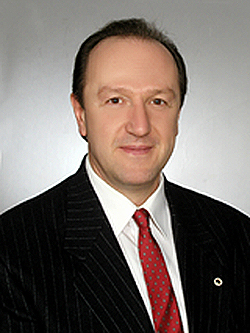



Keynote speaker:
Levent Onural, Bilkent University, Turkey
State of the Art and Future Directions in 3DTV

Although stereoscopic 3D technologies have been as old as their 2D counterparts, the level of acceptance of 3D viewing by the consumers, and therefore, by the industry has been pretty low. A reason for this is the viewing discomfort associated with stereoscopic approaches. Currently available 3D displays are still stereoscopic; improvements allow elimination of special eye-wear, and enhance the quality by tracking observer coordinates. On the other hand, high-end 3D displays, with no viewer discomfort, must be based on coherent and non-coherent holographic techniques, including integral imaging; such displays are still experimental, and acceptable quality can only be achieved after the underlying electronics and optics technologies evolve.
Even though the user-end of the 3DTV or any kind of 3D visual system is the display, the end-to-end operation of such systems naturally involve many more functional components. Capture of 3D scenes, their abstract representation, compression and coding, transmission, and finally the display are the major components. And there are many alternative techniques for each such component. A common capture technique utilizes multiple cameras. The captured moving 3D scenes are represented using computer graphics techniques. Due to redundancy in information content, significant compression of captured 3D data is possible. Transport of 3D video data may be constructed on prior 2D techniques, but the discriminating features and constraints impose a different set of priorities, and thus a different approach, to the transport problem.
3DTV field is a multidisciplinary area, and a successful cooperation of researchers from optics, electronics, signal processing, computer graphics, telecommunications, and other fields are essential for success. Applications of the technology is vast.
Prof. Levent Onural's biographical sketch
Levent Onural was born in Izmir, Turkey in 1957. He received the B.S. and
M.S. degrees in electrical engineering from Middle East Technical
University, Ankara, Turkey, and the Ph.D. degree in electrical and
computer engineering from State University of New York at Buffalo in
1985. He was a Fulbright scholar between 1981 and 1985. After a Research
Assistant Professor position at the Electrical and Computer Engineering
Department of State University of New York at Buffalo, he joined the
Electrical and Electronics Engineering Department of Bilkent University,
Ankara, Turkey, where he is a Professor at present.
His current research interests are in the areas of image and video
processing with emphasis on very low bit rate video coding, texture
modeling, non-linear filtering, holographic TV and signal processing
aspects of optical wave propagation. He has published more than 100 papers
and received about 500 citations. He and his team have contributed to
MPEG-4 activities through COST211 Analysis Model. Currently, he
is the Coordinator of EC funded 3DTV Project.
Dr. Onural is a senior member of IEEE. He was the general co-chair of IEEE
2000 International Conference on Acoustics Speech and Signal Processing
ICASSP'2000. Dr. Onural was the Director of IEEE Region 8
(Europe, Africa and Middle East), and a member of IEEE Board of
Directors, which is the highest board of IEEE, between 2001-2003.
He was a member of IEEE Assembly in 2001-2002. He served as
the 2003 Secretary of IEEE, and he was a member of IEEE Executive
Committee in 2003. Levent Onural was nominated by the IEEE Board of
Directors to the position of 2005 IEEE President-elect (2006 IEEE
President); he is the first person from outside of North America nominated
for this position in 120 years of history of IEEE.
Levent Onural is a recipient of IEEE Third Millenium Medal.
He is currently an associate editor of IEEE Transactions on Circuits and
Systems for Video Technology.